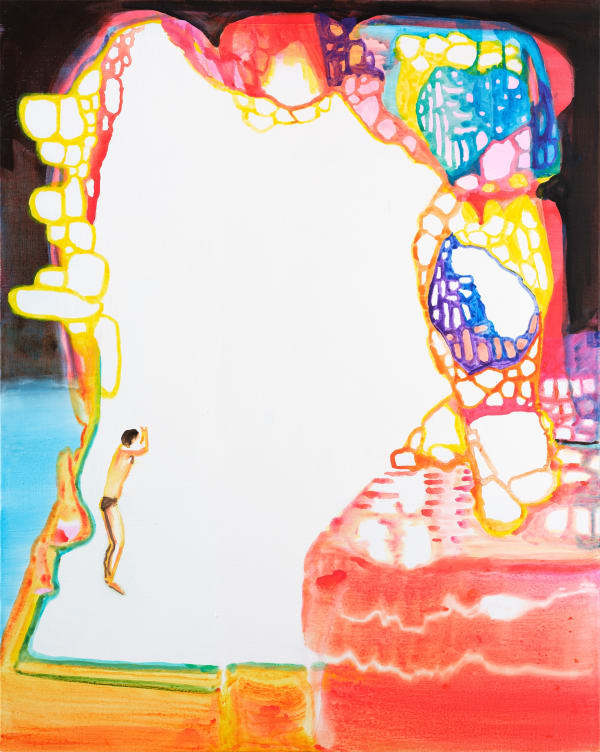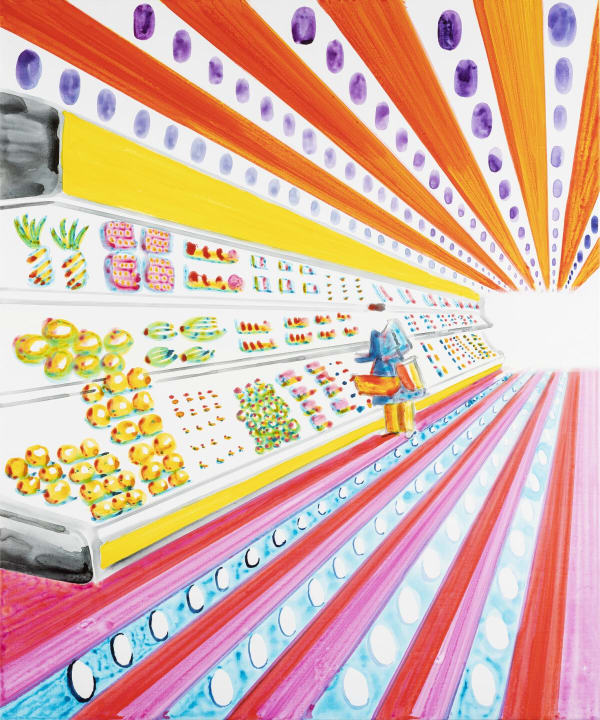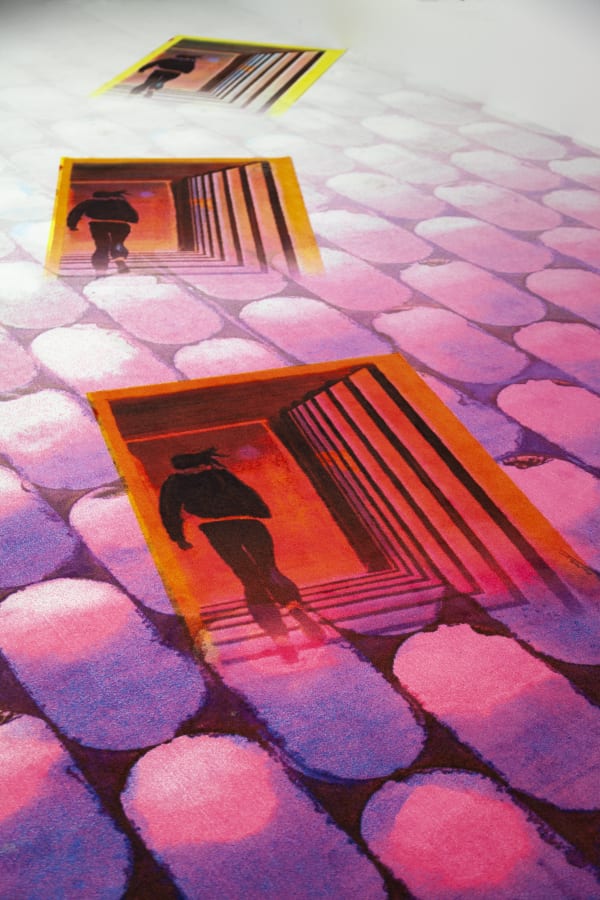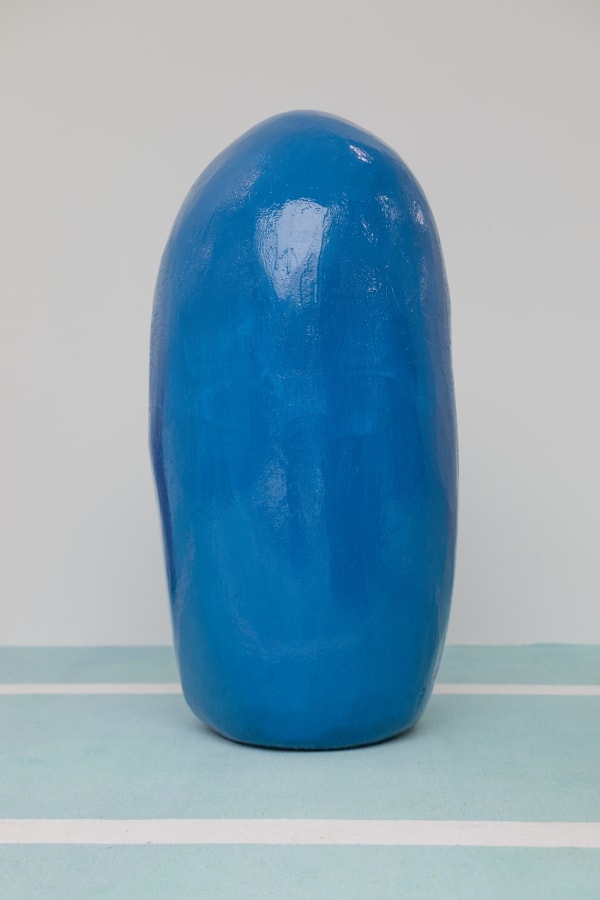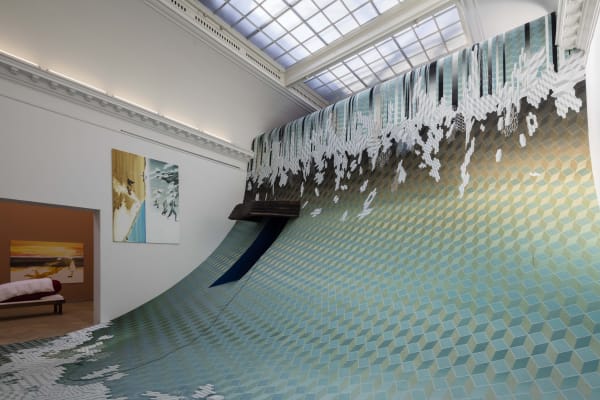John Kørner
-
About
With lightness of touch and painterly dexterity, John Kørner explores his medium’s fundamental duality – its physical presence and its descriptive powers – and the potential for communication or miscommunication that ensues. Kørner’s Problems – oval or egg-like forms that appear in his paintings and as sculptures – allude not to specific problems per se but to the nature of problems as they emerge and are comprehended in the world. They act as metaphors for the human condition and trigger questions about representation, knowledge, or faith – fundamental existential issues or those that allude to specific world events. The accelerated pace of contemporary life is a conceptual touchstone, drawing on ideas of altered states and the sublime in nature while investigating the aesthetics and codes of sport, consumerism and leisure.
Kørner’s work ranges across formats and scales, travelling through art historical tropes and pictorial languages. The social aspect of the viewing experience is of particular interest to the artist, who sometimes shows his work outside the traditional confines of the gallery and creates installations in which elements of theatre and performance add to a sense of collective experience.
-
Biography
Born in Århus, Denmark in 1967, John Kørner lives and works in Copenhagen.
John Kørner: Intercontinental Super Fruits, the first solo museum exhibition of Kørner's work in the United States, was recently on view at the Museum of Contemporary Art Detroit, USA (2021–22). His work was also recently on view at Kunsten Museum of Modern Art Aalborg with the solo exhibition CRAZY AWAKE (2024); and in Work it Out, a group exhibition addressing the working life of the future (2022).
Previously, Kørner has had solo exhibitions at institutional venues including Konsthall 16/Riksidrottsmuseum, Stockholm, Sweden (2019); Museum Dhondt-Dhaenens, Sint-Martens-Latem, Belgium (2018); Helsinki Contemporary, Helsinki, Finland (2018); Museum Emma, Espoo, Finland (2018); Brandts, Odense, Denmark (2016); Museum Belvedere, Oranjewoud, Netherlands (2016); Herning Museum of Contemporary Art, Denmark (2003, 2013); The Workers' Museum, Copenhagen, Denmark (2011); ARoS Århus Kunstmuseum, Denmark (2006) and Moderna Museet, Sweden (2005).
Kørner's work is held in institutional collections including Arken, Museum of Modern Art, Denmark; ARoS, Århus Museum of Art, Denmark; HEART - Herning Museum of Contemporary Art, Hearning, Denmark; Moderna Museet, Stockholm, Sweden; National Gallery of Canada - Musée des beaux-arts du Canada, Canada; National Gallery of Denmark, Copenhagen, Denmark; Royal Museum of Fine Arts, Copenhagen, Denmark; Rubell Family Collection, Miami, USA; Statens Museum for Kunst - SMK, Denmark; Tate, UK.
-
News
-

On view at the British Museum – Nordic noir featuring John Kørner and Tal R
September 9, 2025On view 9 October 2025–22 March 2026, the exhibition features over 150 works by 100 artists from Edvard Munch to the present day, exploring the macabre, melancholy and sometimes provocative themes that run through aspects of Nordic art.Read More -

John Kørner: Venice Lido Light features in Il Giornale dell’Arte
September 5, 2025Riccardo Deni on Kørner's new paintings and sculptures, on view at Victoria Miro Venice from 13 September–25 October 2025.Read More -

On view at Kunsten, Denmark – Crazy Awake, a solo exhibition by John Kørner
2 May 2024On view 3 May–18 August 2024, the exhibition features existing work and new paintings, sculptures and installations. Read more Image: John Kørner, Mountain Shopping, 2017...Read More -

María Berrío, Idris Khan, John Kørner and Tal R create new works for From the Ashes
February 21, 2024Organised by Migrate Art, this fundraising exhibition and auction supports the Xingu Indigenous communities of the Amazon Rainforest. All works have been created using ink,...Read More -

John Kørner: Intercontinental Super Fruits at Museum of Contemporary Art Detroit
November 18, 2021The exhibition (18 November 2021–30 January 2022) presents work that engages artist Kørner’s visual explorations of the allure of product advertisement and globalization in the...Read More -

John Kørner: Running Box at Riksidrottsmuseet, Sweden
May 20, 2019An exhibition (24 May–29 September 2019) of painting, sculpture and installation that takes running as a metaphor for the increasing speed of society. Read more...Read More -

John Kørner talks to Wallpaper* about his exhibition Life in a Box
February 5, 2019The Danish artist gets physical with ‘Life in a Box’ at London gallery Victoria Miro. By Elly Parsons The pace of contemporary life has never...Read More -

John Kørner: Running Problems at Museum Dhondt-Dhaenens
March 25, 2018For his first museum exhibition in Belgium (25 March – 17 June 2018) Kørner creates an integrated environment of painting and installation. A new artist's...Read More -

John Kørner: Tripoli – Lampedusa at Espoo Museum of Modern Art, Finland
February 14, 2018The exhibition (14 February – 29 July 2018) comprises a site-specific installation of works touching upon subjects ranging from global topics such as migration and...Read More -

John Kørner: Altid Mange Problemer at Kunsthal Charlottenborg, Copenhagen
June 18, 201718 Jun – 13 Aug 2017 In the year of John Kørner’s fiftieth birthday, Kunsthal Charlottenborg will present the largest exhibition ever seen of his...Read More -

John Kørner: Life Attacks You
22 April - 23 October 201622 April - 23 October 2016. John Kørner: Life Attacks You What is the smallest number of brush- strokes needed to tell a story? And...Read More -

John Kørner interviewed in Wallpaper*
April 8, 2016Fallen fruit: Victoria Miro presents John Kørner’s ‘Apple Bombs’. By Elly Parsons. Danish artist John Kørner follows world news in his paintings with an almost...Read More
-
-
Gallery Exhibitions
-

John Kørner: Venice Lido Light
13 Sep – 25 Oct 2025 VeniceNew painting and sculpture by John Kørner commenced during a residency with the gallery in Venice.Learn More -

John Kørner: Cosmopolitan Super Fruits
8 Apr – 14 May 2022 London Gallery IIVictoria Miro is delighted to present Cosmopolitan Super Fruits , an exhibition by Danish artist John Kørner. Following Intercontinental Super Fruits , John Kørner’s first solo museum exhibition in the...Learn More -

The Sky was Blue the Sea was Blue and the Boy was Blue
24 Feb – 30 Apr 2021 Miro PresentsAn exhibition of work by 19 artists celebrating the colour blue, available online and on Vortic as part of The London Collective.Learn More -

John Kørner: Life in a Box
1 Feb – 23 Mar 2019 London Gallery IVictoria Miro presents Life in a Box , an exhibition by the Copenhagen-based artist John Kørner, featuring new and recent paintings, and sculptural elements including a climbing frame that also...Learn More -

House Work
25 Jan – 18 Mar 2017 Victoria Miro MayfairIncluding Mamma Andersson, Jules de Balincourt, Hernan Bas, Marc Chagall, Peter Doig, Adrian Ghenie, David Harrison, Karen Kilimnik, John Kørner, LS Lowry, Alice Neel, Celia Paul, Grayson Perry, Tal R,...Learn More -

John Kørner: Apple Bombs
8 Apr – 14 May 2016 Victoria Miro MayfairAn exhibition of new paintings by the Copenhagen-based artist. Painting, for Kørner, serves the unambiguous, if impalpable, function of exercising the imagination much in the same way as a bicycle...Learn More -

John Kørner: Fallen Fruit From Frisland
19 Jan – 2 Mar 2013 London Gallery IThe gallery's third exhibition by the Danish artist. Fallen Fruit from Frisland comprises a series of new paintings presented as part of an installation that features a carpeted floor, rising...Learn More -

In the Company of Alice
22 Jun – 30 Jul 2010 London Gallery I'If you do not solve your painting problem in painting human beings, you do not solve it at all'. Gertrude Stein Hernan Bas, John Currin, Verne Dawson, Peter Doig, Marlene...Learn More -

John Kørner: War Problems
25 Nov 2008 – 24 Jan 2009 London Gallery IWar Problems is a new series of sixteen large-scale works, each representing a Danish solider killed in Afghanistan and each bearing a single name - Anders , Mikkel , Thomas...Learn More -

John Kørner: 2006 Problems
25 Nov – 22 Dec 2006 London Gallery IThere are plenty of known knowns in what John Kørner has recently painted: ships and trees, men and women, crocodiles and birds, town and country-and most apparently in '2006 Problems',...Learn More -

Painting 2004
30 Mar – 24 Apr 2004 London Gallery IHernan Bas, Avner Ben-Gal, Varda Caivano, Charline von Heyl, John Kørner, Dana Schutz, Suling Wang Painting 2004 showcases the work of a younger generation of international artists originating from America,...Learn More
-
-
Contact Form
Contact us regarding available works by John Kørner



